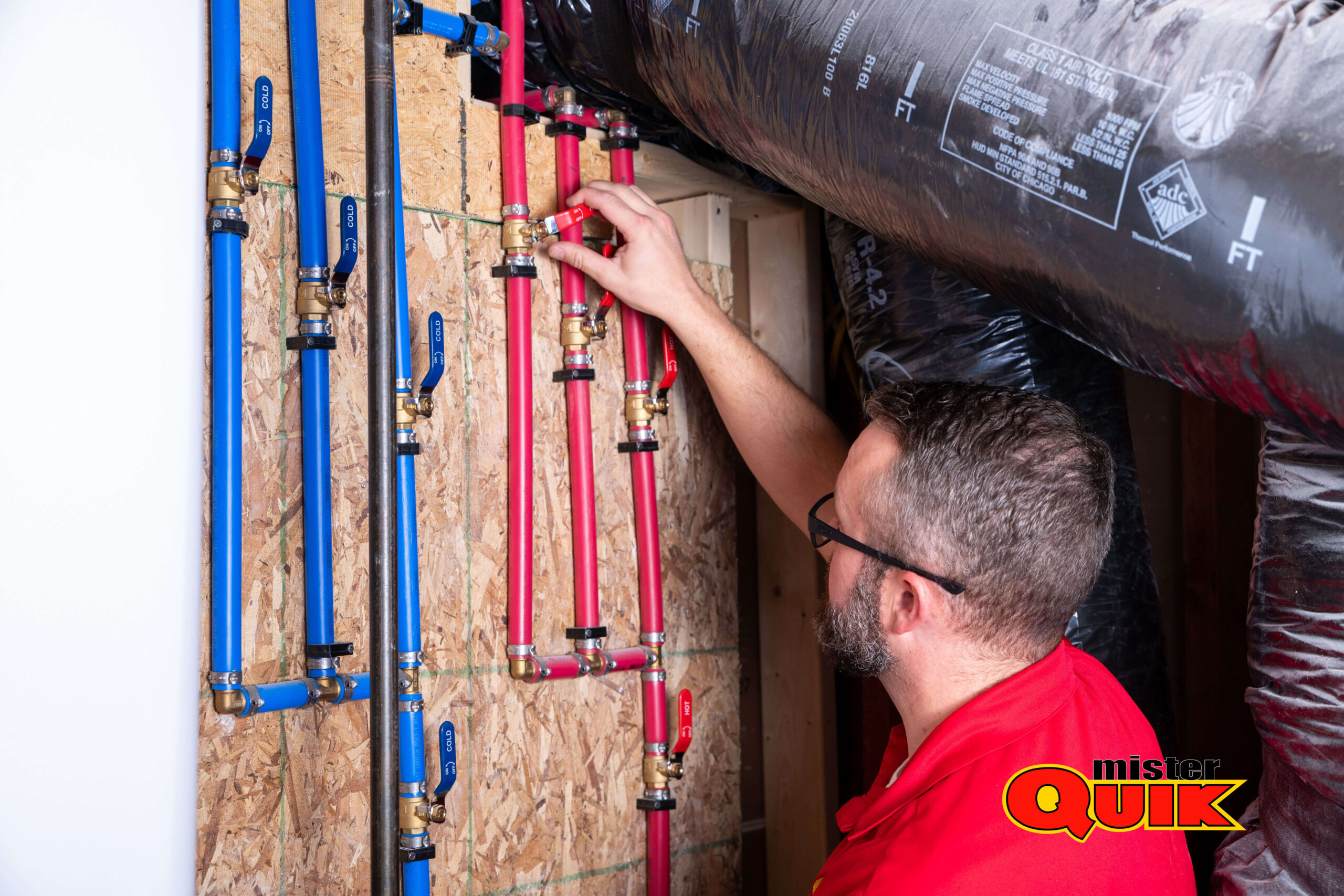Plainfield Water Quality
Schedule on your own without making a call. Click the button below to get started!

Plainfield Water Quality
Clean, safe drinking water is essential for our health and well-being. Fortunately, the Town of Plainfield works hard to provide high-quality tap water to its residents. However, maintaining that quality within your own home is just as important.
Here’s a quick guide to understanding Plainfield’s water quality and how you can keep it safe:
Plainfield’s Water Source: Plainfield’s water comes from wells located underground. The Town treats this water to remove impurities and ensure it meets all federal and state safety standards.
What You Can Do: While the Town treats the water, it travels through miles of pipes before reaching your home. These pipes can sometimes introduce minor amounts of impurities.
Here are some things you can do to maintain your water quality:
- Run the tap for a few seconds before filling your glass to clear any stagnant water.
- Regularly clean your faucet aerators to remove any built-up sediment.
- Consider installing a water filter if you’re concerned about specific contaminants or simply prefer the taste.
Additional Resources:
- For the latest information on Plainfield’s water quality, you can visit the Town’s website or contact the Plainfield Water Works department.
- The Environmental Protection Agency (EPA) also offers a wealth of information on drinking water safety on its website.
By understanding your water source and taking some simple steps, you can help ensure you and your family have access to clean, safe drinking water in your Plainfield home.
Water Quality Testing Near Me
Wondering if your tap water in Plainfield is as pure and refreshing as it could be? Regular water quality testing is a simple and important step toward ensuring a healthy home environment.
Here in Plainfield, our water comes from wells, and like any source, it can pick up trace minerals and other elements as it travels underground. While these are usually harmless in small amounts, testing can help identify any potential concerns.
Here are some of the common contaminants water quality testing can detect:
like iron, manganese, and calcium, can affect taste, odor, and staining.
that, if present in high levels, can pose health risks.
can be harmful to infants and young children.
which can leach from older pipes and plumbing fixtures.
There are several ways to get your water tested in Plainfield: Public health departments often offer free or low-cost testing kits.
Water quality is paramount to human health due to its direct impact on various bodily functions and systems. Contaminated water can harbor pathogens and pollutants, leading to waterborne diseases such as diarrhea, cholera, and typhoid fever. Additionally, poor water quality can contain heavy metals and chemicals, which pose long-term health risks such as cancer, neurological disorders, and reproductive issues. Access to clean and safe drinking water is essential for hydration, proper digestion, and overall well-being, making water quality management crucial for public health initiatives worldwide.
The three primary factors that significantly influence water quality are biological, chemical, and physical. Biological factors encompass the presence of bacteria, viruses, and other microorganisms that can contaminate water sources and pose health risks. Chemical factors include pollutants such as heavy metals, pesticides, and industrial waste, which can leach into water bodies and disrupt ecosystems. Physical factors refer to properties like turbidity, temperature, and sedimentation, which impact the clarity, temperature, and overall composition of water, affecting its suitability for various uses.
Determining if your water quality is poor involves various indicators such as unusual color, odor, or taste in the water, which could suggest contaminants. Testing kits available for purchase or through local health departments can provide detailed analyses of water quality, including levels of bacteria, minerals, and pollutants. Additionally, visible particles or sediment in the water, as well as plumbing issues like corroded pipes or frequent clogs, may signal poor water quality. Regular monitoring and addressing any concerning signs promptly are crucial for maintaining safe and healthy water for consumption and household use.
Poor water quality can result from various factors including industrial pollution, agricultural runoff, sewage discharge, and improper waste disposal. Chemical pollutants such as heavy metals, pesticides, and fertilizers can contaminate water sources, posing risks to human health and aquatic ecosystems. Additionally, microbial contamination from untreated sewage or animal waste can lead to the spread of waterborne diseases. Erosion and sedimentation can also degrade water quality by introducing excess nutrients and reducing clarity. Effective management strategies, including regulatory measures and investment in water treatment infrastructure, are crucial to addressing these issues and ensuring access to clean water for communities.
The biggest threat to water quality is pollution, stemming from various sources such as industrial discharge, agricultural runoff, and improper waste disposal. Chemical contaminants, including pesticides and fertilizers, as well as microbial pathogens, significantly degrade water quality, posing risks to human health and ecosystems. Additionally, urbanization and deforestation exacerbate erosion and sedimentation, further compromising water quality by disrupting natural filtration processes. Effective regulation, sustainable practices, and public awareness are crucial in mitigating these threats and safeguarding water resources for present and future generations.
Water Analysis Methods
Ever wondered how Plainfield keeps its water clean and safe? It all starts with regular testing and analysis! Just like checking your health with a doctor, our water goes through various tests to ensure it meets strict quality standards.


Here are some common methods used for water analysis in Plainfield:
- Physical tests: These check for things you can see or feel, like clarity, color, and odor.
- Chemical tests: These measure the levels of different minerals, metals, and other chemicals present in the water.
- Microbiological tests: These check for the presence of harmful bacteria and other microorganisms.
These tests are conducted at various stages, from the source of the water to your faucet. This helps to identify any potential problems and take corrective action if necessary.
What about home testing?
While home test kits can be a starting point, they typically only test for a limited range of contaminants. For a more comprehensive understanding of your water quality, it’s recommended to rely on the official reports and testing conducted by professionals.
Staying informed:
The Town of Plainfield regularly publishes its water quality reports, which detail the results of its testing program. You can find these reports on the Town’s website or by contacting your local water utility provider. By staying informed about your water quality, you can make informed decisions about your water consumption and take any necessary precautions.
Remember:
If you have any concerns about your water quality, you should always contact your local water utility provider for further information and guidance.
Water Quality Issues
Ever wondered how Plainfield keeps its water clean and safe? It all starts with regular testing and analysis! Just like checking your health with a doctor, our water goes through various tests to ensure it meets strict quality standards.
Here are some common methods used for water analysis in Plainfield:


These check for things you can see or feel, like clarity, color, and odor.


These measure the levels of different minerals, metals, and other chemicals present in the water.



These check for the presence of harmful bacteria and other microorganisms.



While home test kits can be a starting point, they typically only test for a limited range of contaminants. For a more comprehensive understanding of your water quality, it's recommended to rely on the official reports and testing conducted by professionals.
Water Quality Company
Clean, safe drinking water is essential for our health and well-being. But with all the information out there, it can be confusing to understand what’s in your water and how to ensure its quality.
Here in Plainfield, Indiana, our water comes from wells. While this source generally provides good quality water, it’s important to be aware of potential contaminants and take steps to protect your health.
Understanding Water Quality Reports:
The Town of Plainfield releases annual Consumer Confidence Reports (CCRs) detailing the quality of our drinking water. These reports list the levels of various contaminants detected in the water, along with explanations of their potential health effects.
Common Water Quality Concerns:
Some common concerns for Plainfield residents include:
- Disinfectants: Chlorine is used to disinfect the water, but it can sometimes react with other chemicals to form disinfection byproducts (DBPs) like haloacetic acids (HAAs) and trihalomethanes (THMs). While the levels are typically within safe limits, some individuals may be more sensitive to these byproducts.
- Minerals: Naturally occurring minerals like iron and manganese can affect the taste and appearance of the water, but they are not typically harmful.
- Lead: Lead can enter drinking water through lead pipes and fixtures, especially in older homes.
Taking Action for Safe Drinking Water:
Here are some things you can do to ensure your drinking water is safe:
- Review your CCR: This report provides valuable information about your specific water quality.
- Consider water filtration: If you’re concerned about contaminants or the taste of your water, a water filtration system can be a helpful option.
- Test your water: If you have any concerns about lead or other specific contaminants, you can have your water tested by a certified laboratory.
Importance of Water Quality Monitoring
Clean, safe water is essential for our health and well-being. Here in Plainfield, Indiana, we’re fortunate to have a reliable water supply. But just like anything else, it’s important to keep an eye on its quality. That’s where water quality monitoring comes in.
Think of it like a checkup for your water. It involves regularly testing the water for various things like: Microscopic organisms: These can sometimes be harmful, so monitoring helps ensure they're within safe limits. Chemicals: Testing helps detect any presence of unwanted chemicals that might affect the water's safety or taste. Minerals: While some minerals are beneficial, others can be present in excess and cause problems like staining or pipe corrosion.
Regular monitoring helps identify any potential issues early on. This allows for taking swift action to address them, preventing any harm to our health or damage to our plumbing systems. It also helps ensure we continue to enjoy the clean, safe water we deserve.
Our local water treatment facilities are responsible for conducting regular water quality monitoring. They follow strict guidelines set by the Environmental Protection Agency (EPA) to ensure our water meets all safety standards.
While the city handles the majority of monitoring, you can also play a role: Be informed: Stay updated on any water quality advisories issued by your local water authority. Notice changes: If you notice any changes in your water's taste, odor, or color, report it to your water provider. Test your well water: If you have a private well, consider having it tested regularly for specific contaminants.
By working together, we can ensure the continued quality and safety of our water supply in Plainfield.
- Appearance: Is the water clear or cloudy? Does it have any unusual color or sediment?
- Smell: Does the water have any unpleasant odors?
- Taste: Does the water taste different than usual? Is it metallic, salty, or bitter?
- Simple test kits: Use readily available test kits to check for specific concerns like chlorine levels or hardness.
- Leaks: Inspect for any leaks around faucets, pipes, or your water heater.
- Fixtures: Look for any signs of corrosion or rust on faucets, showerheads, or appliances.
- Construction: Has there been any recent construction activity near your home that could disturb the water system?
- Heavy rain: Have there been heavy rains that might impact your well water (if applicable)?
- Report concerns: If you suspect an issue with your water quality, report it to your local water provider immediately.
- Seek professional help: If further troubleshooting is needed, consult a qualified plumber or water treatment specialist.






